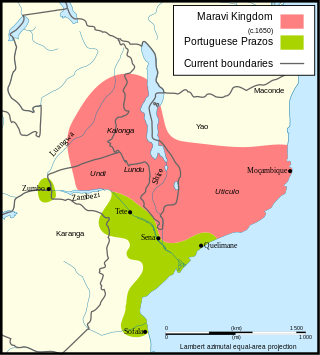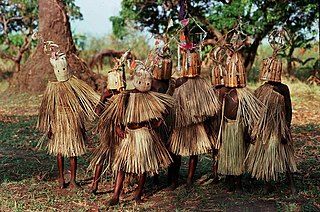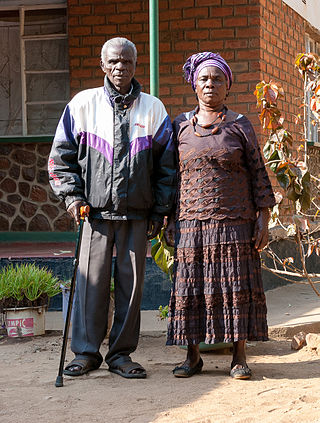Related Research Articles
The history of Malawi covers the area of present-day Malawi. The region was once part of the Maravi Empire. In colonial times, the territory was ruled by the British, under whose control it was known first as British Central Africa and later Nyasaland. It becomes part of the Federation of Rhodesia and Nyasaland. The country achieved full independence, as Malawi, in 1964. After independence, Malawi was ruled as a one-party state under Hastings Banda until 1994.

Zanzibar is an insular semi-autonomous region which united with Tanganyika in 1964 to form the United Republic of Tanzania. It is an archipelago in the Indian Ocean, 25–50 km (16–31 mi) off the coast of the African mainland, and consists of many small islands and two large ones: Unguja and Pemba Island. The capital is Zanzibar City, located on the island of Unguja. Its historic centre, Stone Town, is a World Heritage Site.

The Tumbuka is a Bantu ethnic group found in Malawi, Zambia and Tanzania. Tumbuka is classified as a part of the Bantu language family, and with origins in a geographic region between the Dwangwa River to the south, the North Rukuru River to the north, Lake Malawi to the east, and the Luangwa River. They are found in the valleys near the rivers, lake as well as the highlands of Nyika Plateau, where they are frequently referred to as Henga although this is strictly speaking the name of a subdivision.

Tippu Tip, or Tippu Tib, real name Ḥamad ibn Muḥammad ibn Jumʿah ibn Rajab ibn Muḥammad ibn Saʿīd al Murjabī, was an Afro-Omani ivory and slave owner and trader, explorer, governor and plantation owner. He worked for a succession of sultans of Zanzibar and was the Sultan of Uterera, a short-lived state in Kasongo, Maniema ruled by himself and his son Sefu who was an emir of the local WaManyema.

Nkhotakota (Un-kho-tah-kho-tuh) is a town and one of the districts in the Central Region of Malawi. It is on the shore of Lake Malawi and is one of the main ports on Lake Malawi. As of 2018, Nkhotakota had a population estimated at 28,350. The district had a population of 301,000.

The Nyamwezi, or Wanyamwezi, are one of the Bantu groups of East Africa. They are the second-largest ethnic group in Tanzania. The Nyamwezi people's ancestral homeland is in parts of Tabora Region, Singida Region, Shinyanga Region and Katavi Region. The term Nyamwezi is of Swahili origin, and translates as "people of the moon" or "people of the west", the latter being more meaningful to the context.

Maravi was a kingdom which straddled the current borders of Malawi, Mozambique, and Zambia, in the 16th century. The present-day name "Maláŵi" is said to derive from the Chewa word malaŵí, which means "flames". "Maravi" is a general name of the peoples of Malawi, eastern Zambia, and northeastern Mozambique. The Chewa language, which is also referred to as Nyanja, Chinyanja or Chichewa, and is spoken in southern and central Malawi, in Zambia and to some extent in Mozambique, is the main language that emerged from this empire.

The Abushiri Revolt, also known as the Slave Trader Revolt, but generally referred to by modern historians as the Coastal Rebellion, was an insurrection in 1888–1889 by the Arab, Swahili and African population of the coast of what is now Tanzania. This coast had been leased, under protest, to Germany by the Sultan of Zanzibar in 1888. The rebellion was eventually suppressed by a German expeditionary force commanded by Hermann Wissmann.

The Yao people are a major Bantu ethnic and linguistic group living at the southern end of Lake Malawi. They played an important role in the history of Southeast Africa, notably in the 19th century. The Yao are a predominantly Muslim-faith group of about two million, whose homelands encompass the countries of Malawi, the north of Mozambique, and the Ruvuma and Mtwara Regions of Tanzania. The Yao have a strong cultural identity, transcending national borders.
Jumbe may refer to:

Mikindani is a historic coastal town located in Mtwara-Mikindani District of Mtwara Region in Tanzania. The name comes from the Swahili word mikinda which means "young coconut trees". Therefore, the term "Mikindani', literally means "the place where there are young coconut trees" in old Swahili language. Mikindani is part of the city of Mtwara and is governed by the Mtwara Mikindani Municipal Council. The site is a registered National Historic Site.

Islam is the second largest religion in Malawi behind Christianity. Nearly all of Malawi's Muslims adhere to Sunni Islam. Though difficult to assess, according to the CIA Factbook, in 2018 about 13.8% of the country's population was Muslim. Muslim organisations in the country claim a figure of 15-20%. According to the latest census (2018), Muslims make up 13.8% (2,426,754) of the country's population. According to the Malawi Religion Project run by the University of Pennsylvania, in 2010 approximately 19.6% of the population was Muslim, concentrated mostly in the Southern Region.
People have lived in Zanzibar for 20,000 years. The earliest written accounts of Zanzibar began when the islands became a base for traders voyaging between the African Great Lakes, the Somali Peninsula, the Arabian Peninsula, Iran, and the Indian subcontinent. Unguja offered a protected and defensible harbour, so although the archipelago had few products of value, Omanis and Yemenis settled in what became Zanzibar City as a convenient point from which to trade with towns on the Swahili Coast. They established garrisons on the islands and built the first mosques in the African Great Lakes Region.

The Swahili coast is a coastal area of East Africa, bordered by the Indian Ocean and inhabited by the Swahili people. It includes Sofala ; Mombasa, Gede, Pate Island, Lamu, and Malindi ; and Dar es Salaam and Kilwa. In addition, several coastal islands are included in the Swahili coast, such as Zanzibar and Comoros.
The Shirazi people, also known as Mbwera, are a Bantu ethnic group inhabiting the Swahili coast and the nearby Indian ocean islands. They are particularly concentrated on the islands of Zanzibar, Pemba and Comoros.

The Chikulamayembe are a dynasty of kings established among the Tumbuka people in the Nkhamanga-Henga area of Northern Malawi. The Chikulamayembe originally ruled from around 1805, becoming weaker from the 1830s and losing power by the 1870s and their dynasty was re-established in 1907.
The name Karonga War is given to a number of armed clashes that took place between mid-1887 and mid-1889 near Karonga at the northern end of Lake Malawi in what is now Malawi between a Scottish trading concern called the African Lakes Company Limited and elements of the Ngonde people on one side and Swahili traders and their Henga allies on the other. In the 19th century, it was referred to as the “Arab War”, despite few actual Arabs being involved. Although these conflicts predate formal endorsement of a British Central Africa Protectorate west of Lake Malawi in 1891, European involvement, both by the African Lakes Company and by Germans attempting to prevent Swahili slave trading around Lake Tanganyika in German East Africa, had upset the previous balance between the Ngonde and their neighbours and created the conditions for this conflict. It was between the Tumbuka and Nyakyusa-Ngonde ethnic groups.

Albrecht Roscher was a German explorer of Africa. He was murdered near Lake Malawi in 1860.

The Indian Ocean slave trade, sometimes known as the East African slave trade, involved the capture and transportation of predominately black African slaves along the coasts, such as the Swahili Coast and the Horn of Africa, and through the Indian Ocean. The areas impacted included East Africa, Southern Arabia, the west coast of India, Indian ocean islands and southeast Asia including Java. The source of slaves was primarily in sub-saharan Africa, but also included other parts of Africa and the Middle East, Indian Ocean islands, as well as south Asia. While the slave trade in the Indian Ocean started 4,000 years ago, it expanded significantly in late antiquity with the rise of Byzantine and Sassanid trading enterprises. Muslim slave trading started in the 7th century, with the volume of trade fluctuating with the rise and fall of local powers. Beginning in the 16th century, slaves were traded to the Americas, including Caribbean colonies, as Western European powers became involved in the slave trade. Trade declined with the abolition of slavery in the 19th century.

Hassan bin Omari, also known as Makunganya, one of the Makanjila Yao people, was one of the most influential and successful Muslim ivory and slave traders and caravan raiders in present-day south-east Tanzania, and was a chief of the Mavuji. Having attacked the German occupying forces, he was eventually caught and hanged by German troops, along with his associates.
References
- 1 2 3 4 5 6 "Malawi Slave Routes and Dr. David Livingstone Trail". UNESCO World Heritage Centre. Retrieved 2019-04-27.
- 1 2 3 4 Kalinga, Owen J. M. (2012). Historical Dictionary of Malawi. Rowman & Littlefield. ISBN 9780810859616.
- 1 2 3 4 Bone, David S. (1982). "Islam in Malawi". Journal of Religion in Africa. 13 (2): 126–138. doi:10.2307/1581207. ISSN 0022-4200. JSTOR 1581207.
- 1 2 3 4 5 Morris, Brian (2006). "The ivory trade and chiefdoms in pre-colonial Malawi". The Society of Malawi Journal. 59 (2): 6–23. ISSN 0037-993X. JSTOR 29779210.